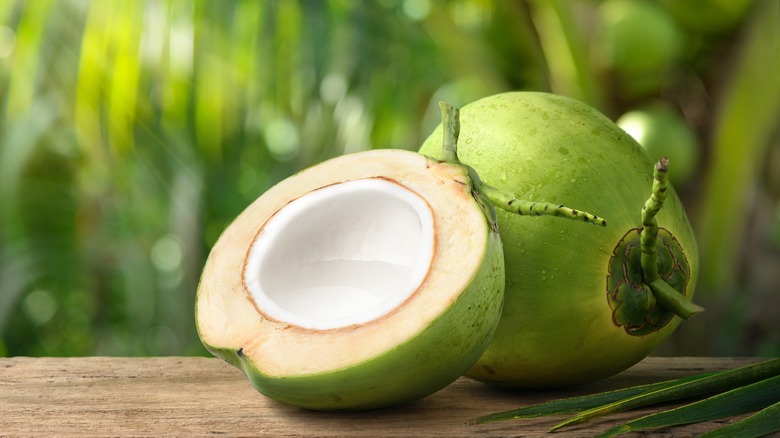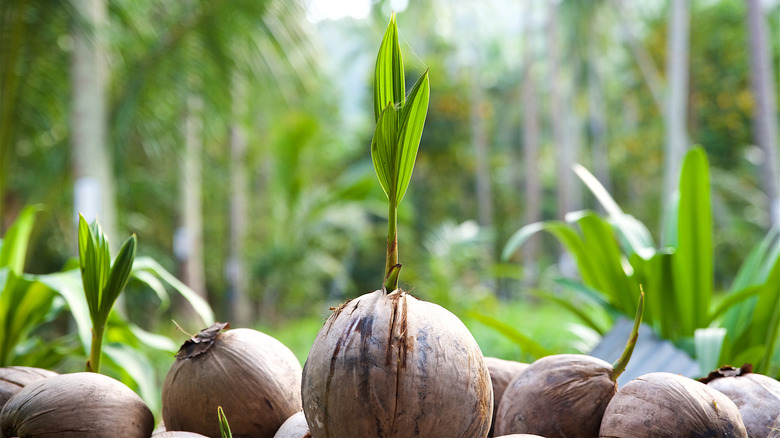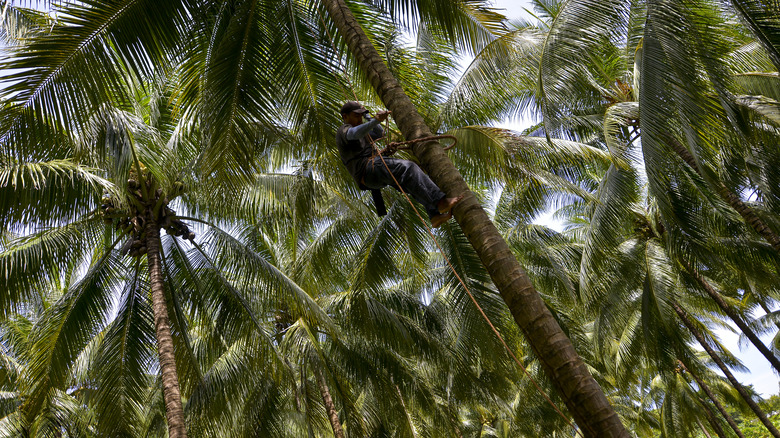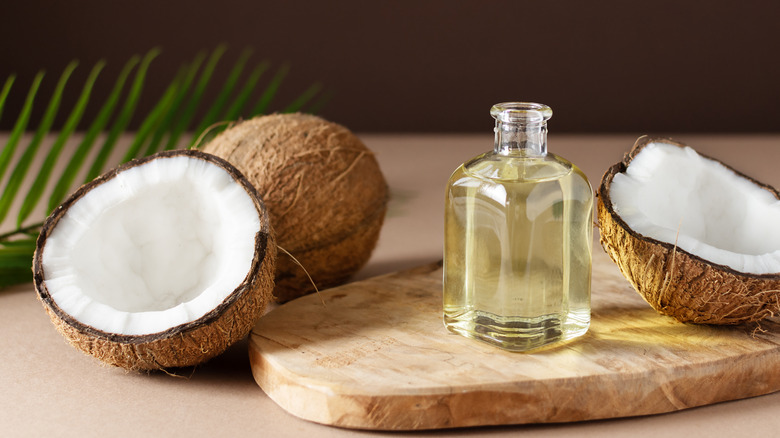Which Country Produces The Most Coconuts?
From curries and cookies to a cooling workout beverage — coconuts constitute a dazzling variety of culinary applications. Long esteemed for their usefulness, the hard-shelled fruit was carried by Arab traders to Africa, through the silk road to Europe, and further onwards throughout the New World. Now, the picturesque palm grows on every subtropical coastline in the world via Aramco World.
Researchers have traced the globalized palm to two distinct lineages, one emerging in Malay and the other in India. Genetic testing can categorize every coconut tree based on these varieties. While coconuts in the Caribbean are of Indian descent, the ones from Central America are of Malay origin, per Scientific American. Although many types are now cultivated, the sweet-fleshed Malayan Dwarf coconut has become the most popular, according to Fruitstand. Fast-growing, bountiful, and hardy, this shorter tree is the most adept to growing conditions in Florida and California, says the U.S. Department of Agriculture. However, most of the U.S. is too cold for coconut growth — let's dive into where the plant thrives.
Coconuts thrive in warm coastal environments
Coconuts naturally grow between latitudes 25 degrees north and south of the equator. The tree flourishes in warm climates — 95 degrees Fahrenheit is ideal for germination, while temperatures under 72 degrees stunt growth. Humid coastal areas are the best-suited environment, reports Tree Journey.
In addition to rainfall, the palm needs ample circulating groundwater. As a result, mass production is difficult; most farming occurs on small-scale native cultivations. The process is not entirely wild. Coconuts are first propagated in a nursery bed and then transferred to a field for four to 10 months. After five to six years, the palms will start bearing fruit — upwards of 100 coconuts a year, per Britannica.
Despite their ubiquity, sustainable coconut agriculture is facing several stressors. The plant doesn't adapt well to human intervention, consistently at risk of pests and infections. Additionally, climate change is drying up growth areas, limiting water that's crucial for the tree. Increased genetic and breed research is helping these challenges, boosting the plant's yield, per Science Direct. Such an array of factors means that certain environments dominate worldwide production — not far from the plant's origins.
Indonesia and the Phillipines lead global coconut production
The island nation of Indonesia grows the most coconuts in the world, producing an astounding 16.82 million metric tons in 2020 (via Statista). The Phillippines and India trail not too far behind, with the three countries accounting for over 70% of global production. Most international coconut trade stays within Asia, as Thailand and Malaysia are the top importers, outlines Business Wire.
While coconut flakes and milk are the most frequent pantry items, most productions center on oil extraction. By drying the contained white flesh, called copra, the fatty extract is pressed and used in various applications. Not exclusively culinary in aim, coconuts are also a crucial component of many soaps and cosmetics, reports Fruit and Spice Park. In high-volume growers in Indonesia and the Philippines, the manufacture of oil involves a complex trade network. While some small villages fire coconuts in makeshift kilns next to farms, others export coconuts to production centers for meager profits. As outlined in "Coconut: How the Shy Fruit Shaped Our World" by Robin Laurance, the economic sustainability of the fruit is improving, but still imperfect, accessed via The History Press.
Coconut's versatility is expanding worldwide
More than an economic resource, the coconut tree carries cultural and spiritual significance due to its versatility. In Indonesia, it's known as the "Tree of abundance," while Filipinos refer to it as the "Tree of life." At least 83 functional uses are recorded from the plant, ranging from musical instruments, and eating utensils, to toothbrushes. Such a centrality is accompanied by spiritual importance. In Hinduism, coconuts are a cornerstone of rituals and festivals. Offerings are frequently accompanied by a coconut, and almost all houses in South India plant a palm for good luck, per "Coconut – History, Uses, and Folklore" via ResearchGate.
With the expanding trend of vegan products, the demand for coconut is rapidly increasing in the U.S. From 2020 to 2027, the market is expected to reach $23.39 billion, a 10.5% increase. Not only is coconut oil a more frequent addition to the pantry, but the fruit's varied use in health and self-care productions is becoming increasingly recognized, says Fortune Business Insights. Perennially popular, it's hard to imagine a world without coconut palms. Nearly every continent has embraced the fruit and all of its bounties –it's one to cherish.



